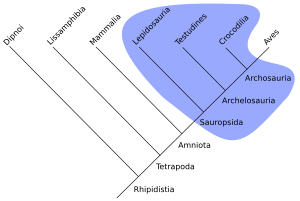Paraphyly facts for kids
Paraphyly is a word used in cladistics, which is the study of how living things are related through evolution. It describes a group of organisms that includes a common ancestor and some, but not all, of its descendants.
Imagine a family tree. A paraphyletic group would be like a family that includes a grandparent and some of their children, but purposely leaves out other children or grandchildren. In biology, this means the group is missing some branches of the evolutionary tree that came from that ancestor.
For example, the traditional group of reptiles (called Sauropsida) is often considered paraphyletic if it doesn't include birds. This is because birds are actually descendants of ancient reptiles, specifically small theropod dinosaurs. To make the group complete and include all descendants, birds must be part of the reptile group.
When a paraphyletic group is "fixed" by adding the missing descendants, it becomes a monophyletic group. A monophyletic group includes a common ancestor and all of its descendants. So, if birds are included in the Sauropsida group, then it becomes monophyletic. Many older ways of classifying animals were paraphyletic because scientists didn't always know all the evolutionary connections.
Contents
Understanding Evolutionary Groups
Scientists use different terms to describe how groups of organisms are related based on their shared ancestors.
What is a Common Ancestor?
Every living thing on Earth is related to every other living thing if you go back far enough in time. A common ancestor is the single species from which two or more different species have evolved. Think of it like a great-grandparent who is the ancestor of all their grandchildren and great-grandchildren.
Monophyletic Groups: The Complete Family
A monophyletic group is the ideal type of group in cladistics. It includes a common ancestor and all of its descendants. This is like a complete family tree branch, showing everyone who came from that one ancestor. For example, all mammals form a monophyletic group because they all share a single common ancestor, and no descendants of that ancestor are left out.
Another type of group is polyphyletic. This group includes organisms that do not share a recent common ancestor. Instead, they are grouped together because they have similar features that evolved separately. For example, if you grouped all flying animals (birds, bats, and insects) together just because they can fly, that would be a polyphyletic group. They all fly, but they evolved flight independently and don't share a recent common ancestor that also flew.
Why Paraphyly Matters
Understanding paraphyly is important for scientists because it helps them create more accurate and natural classifications of life. When a group is paraphyletic, it means our understanding of its evolutionary history is incomplete. By identifying and correcting paraphyletic groups, scientists can better reflect the true relationships between species. This helps us understand how life on Earth has changed and diversified over millions of years.
Related topics
Images for kids
-
In this phylogenetic tree, the green group is paraphyletic; it is composed of a common ancestor (the lowest green vertical stem) and some of its descendants, but it excludes the blue group (a monophyletic group) which diverged from the green group.
See also
 In Spanish: Parafilético para niños
In Spanish: Parafilético para niños



